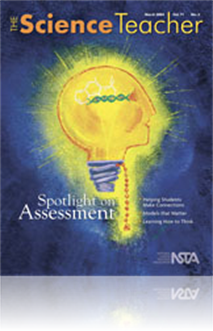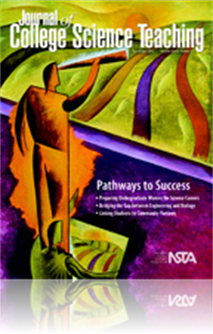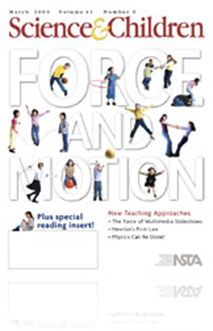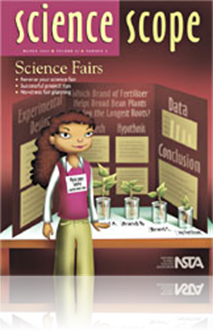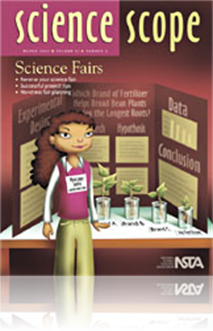All Resources
Journal Article
One way for teachers to show a small specimen to an entire class is by placing the specimen in a small, transparent display case, such as a Petri dish. This allows students to closely observe the specimen and reduces the chance it might become damage...
Journal Article
Nontraditional laboratories can provide primary pathways by which students comprehend and apply modern astronomy. To teach a nontraditional astronomy lab, we must give students opportunities to critically contemplate unsolved questions and evaluate c...
Journal Article
Idea Bank: What's Up with Kudzu?
The abundance of Kudzu—a Japanese vine—in the state of Mississippi provides a natural pathway for discovery opportunities. All over the South in late spring and summer, Kudzu wreaks havoc; the vine can overtake buildings if left unchecked and oft...
Journal Article
Teaching Through Trade Books: May the Force Be with You!
Students’ fascination with moving objects—as well as with how they themselves move—can inspire numerous physical science investigations. This month's Teaching Through Trade Books column focuses on two books about motion: Go, Go, Go! Kids on the...
Journal Article
Enhancing students’ cognitive development is a priority—students must learn how to think. Inquiry instruction provides students with tools to make decisions based upon available evidence and an opportunity to develop and practice their thinking...
Journal Article
Science Sampler: No stress science fair
Teachers can combat two common pitfalls of science fairs—finding time and excessive parental involvement—by working the projects into the classroom curriculum. Students complete independent research projects early in the year and showcase their r...
Journal Article
Assessing Student Understanding
Science education has moved from the traditional lecture-and-demonstration model toward a student inquiry model. Although science teachers know that inquiry teaching is desirable, they are frequently at a loss when it comes time to assess students. T...
Journal Article
The following question is addressed in this month’s column: An email debate among science teachers focused on the explosive nature of “superheated” microwaved water. Could someone address the real science that either debunks or supports this no...
Journal Article
Few things capture the spirit of spring like flying a kite. Watching a kite dance and sail across a cloud-spotted sky is not only a visually appealing experience, it also provides a foundation for studies in science and mathematics. In this kite-buil...
Journal Article
Scope on the Skies: And now there are five
This month opens with four of the five brightest planets (Venus, Mars, Saturn, and Jupiter) very visible as they line up across the evening skies after sunset, stretching from the western horizon to the southeastern horizon. The month closes with the...
Journal Article
Chemistry is a difficult subject for students to understand because its core concepts—atoms, molecules, and chemical bonds—cannot be directly observed. Students primarily learn chemistry through their senses and do not distinguish between explana...
Journal Article
With some creative integration, this teacher increased student interest in physical science and received a 2002 NSTA Toyota TAPESTRY Grant. Her project, a physics trail on school grounds, included stations devoted to glacial history, animals, Nati...
Journal Article
Reverse Your Science Fair with Educational Partnerships
Do your students roll their eyes and groan at the idea of another science fair? If so, try implementing a different twist on science fairs, where teachers can arrange for adults to present projects to students. This non-traditional fair solicits facu...
Journal Article
Outstanding Science Trade Books for Student K-13 (Books Published in 2003)
The Outstanding Science Trade Books for Students K-12 are selected every fall by an NSTA committee. These are the books selected for the publishing year 2003. Texts are cited for having substantial science content, clear, accurate, up-to-date inform...
Journal Article
Science Sampler: Multiple intelligences and lab groups
Science teachers who are committed to excellence in the classroom continually seek ways to improve teaching and learning, and the concept of multiple intelligences holds promise as a method for accomplishing this. Acknowledging these intelligences of...
Journal Article
Multidisciplinary Explorations
A course integrating the fields of engineering and biology was developed to teach students to solve real-world problems that included aspects from both disciplines. Computer simulations were developed and carried out, and findings were presented in a...
Journal Article
Editor's Corner: Modeling Clay, Whiteboards, and Poster Sessions
As classroom teachers, we develop great expertise with sticky notes, whiteout, and highlighters. They are the staples of our daily survival along with the trusty stapler and scotch tape dispenser (usually empty) found on our desks. This month’s col...



